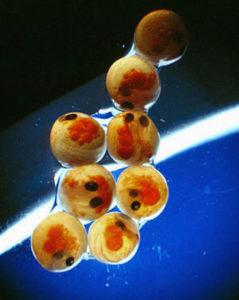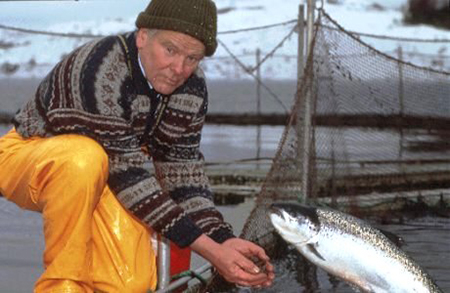Use of genetically improved stocks can overcome limiting factors, improve production cost-efficiency

The single most important factor in the green revolution that increased plant production several times over a few years and nearly eliminated the famine in Asia was the availability of genetically improved seeds. Today, large countries like China and India produce food in excess. In aquaculture, however, a blue revolution has been talked about for 20 years without similar success. The lack of genetically improved stocks is a major reason for this.
It is reasonable to assume that less than 10 percent of today’s aquaculture production is based on genetically improved animals. Animal breeding and selection must be taken more seriously by the aquaculture industry, because it can significantly contribute to solving many factors that currently limit industry expansion.
Selective breeding
In recent years, there have been many reports about response to selection from breeding programs and selection experiments with aquaculture species. Table 1 presents a summary of reported selection responses for growth rate in several species.
Gjedrem, Response to selection for growth rate, Table 1
| Species | Genetic Gain/ Generation (%) | Number of Reports | Number of Generations Selected |
|---|---|---|---|
| Coho | 10.1 | 1 | 4 |
| Rainbow Trout | 11.5 | 2 | 3; 2 |
| Atlantic Salmon | 13.6 | 3 | 1; 1; 6 |
| Channel Catfish | 17.5 | 2 | 1; 1 |
| Tilapia | 13.5 | 2 | 2; 12 |
| Rohu Carp | 17.0 | 1 | 2 |
| Shrimp | 9.7 | 2 | 1: 1 |
| Oysters | 14.3 | 4 | 1: 2; 1; 1 |
| Clams | 9.0 | 1 | 1 |
| Scallops | 17.0 | 2 | 1; 1 |
Genetic gains
The genetic gains obtained are surprisingly high, averaging 13.3 percent per generation. These responses are substantially higher than those achieved with livestock, and indicate it is possible to more than double growth rate in six generations of selection. Genetic gains of this magnitude are already documented for Atlantic salmon and Nile tilapia.
Such a twofold increase in growth rate will dramatically increase production efficiency, and retention of energy and protein in the species. It also reduces risks, including:
- Time to market size; cut by about 30 percent, increasing turnover rate.
- Mortality, because it takes less time to reach market size. For several species, mortality is reduced due to a positive genetic correlation between growth rate and survival.
- Feed conversion rate, mainly due to lower maintenance requirements.
Generation interval
Generation intervals vary among species. Several shrimp and tilapia species are exceptional performers, with a generation interval of one year – indicating that effective selection can double their growth rate in only six years. For Indian carp, common carp, Crucian carp, sea bream, sea bass, rainbow trout, and Coho salmon, the generation interval is usually two years. For other species like Chinese carp, milkfish, yellowtail, channel catfish, and Atlantic salmon, it is three years or more.
Single, several traits
If selection is done for several traits simultaneously, the selection response for each will be reduced, as compared to selection response obtained in single-trait selection. For well-designed selection programs, genetic gains can be predicted with high accuracy when phenotypic and genetic parameters are known.
Crossbreeding
Less information is available about the magnitude of heterosis (hybrid vigor) that can be obtained in crossbreeding programs. In common carp and channel catfish, some experiments have shown significant heterosis, demonstrated through an average performance of offspring animals that exceeds the mean performance of the parental lines involved. However, if one compares crossbred animals with the best-performing parental strain, the results are not so convincing. In Atlantic salmon, rainbow trout, tilapia, and shrimp the effect of heterosis seems to be marginal.
Furthermore, heterotic effects do not accumulate over generations, so a continuous, long-term response in a crossbreeding program requires that the parental stocks or lines be improved through additive selection. Therefore, crossbreeding should not be the only method used.
Starting a breeding program
To start a breeding program, it is necessary to invest in testing facilities and plan the elements of the program. Therefore, an ambitious breeding program should aim at serving a large population. Additional funding is needed to cover operating costs during the first years, because it takes time before improved animals (eggs, fry, or spawners) can be marketed, particularly for species with long generation intervals.
Detailed plan
A commercial company can start and run a breeding program, or farmers may want to form a cooperative breeding company. The first step is to formulate a detailed breeding plan with the assistance of professionals who know the science of selective breeding and have experience in the field.
Broad genetic basis
It is essential that the base populations have a broad genetic basis. This can be obtained by sampling broodstock from the best-performing farmed strains as well as wild stocks. Crossing the available stocks using many spawners from each stock can produce a synthetic population well suited for a selection program.
Selection limits
In some experiments with laboratory animals, responses to selection have reached a limit after 20-30 generations, and reproduction traits are often reduced in strongly selected lines. However, livestock has been selected for increased production for many generations, and there really is no trend of reduced genetic gain in any well-designed program.
A good example of the tremendous potential of long-term response to selection for a quantitative trait was given by F. D. Enfield (1979). He worked with the beetle Tribolium and selected for weight of pupa for 120 generations without marked decrease in genetic gain per generation. Both the additive genetic variance and phenotypic variance increased during the course of the experiment, and heritability showed only a slight decline. The total response to selection represented a change of 28 genetic and 17 phenotypic standard deviation units, based on the original estimates of these parameters.
Few programs for fish/shellfish
Genetically improved stocks are needed to make aquaculture production more sustainable, efficient, and competitive. Although the advantages of selective breeding are well documented, few producers currently use improved stocks. The possible reasons are varied.
Lack of investment capital
Establishing a well-designed breeding program requires initial investment. However, with expected cost/benefit ratios ranging 1/10 to 1/30 (depending on species and size of target productions), lack of investment capital should generally not be a limiting factor.
Selection too conventional

Recent developments in molecular genetics and embryology may have affected the general perception of quantitative selection. However, virtually all the genetic improvements seen in livestock and fish to date have resulted from conventional breeding programs.
The nature of economically importance traits in aquaculture are typically multifactorial. They are likely influenced by a large number of individual genes (each with a small effect on the phenotypic expression), which may make them among the most difficult to handle by genomic strategies.
Lack of cooperation, information
Since the establishment and operation of breeding programs is expensive, it is not realistic for small farmers to have their own programs. Cooperation is certainly needed, but in developing countries in particular, a lack of communication between research and extension services and farmers could be another factor that limits further selective breeding.
Farmers skeptical
It is common for aquafarmers to use local strains of fish or shellfish for farming, assuming they are the most suitable ones. Farm trials should be advocated to compare the productivity of local and genetically improved stocks.
Conclusion
During the last 10 years, world production of fish and shellfish has grown by 11 percent per year, which is a remarkable and very positive development. Future expansion in aquaculture production will require more land, coastline, offshore areas, and feed resources – all of which can be expected to become increasingly limiting factors. The use of genetically improved stocks can reduce these problems considerably, and also significantly improve production cost-efficiency.
(Editor’s Note: This article was originally published in the February 2002 print edition of the Global Aquaculture Advocate.)
Now that you've finished reading the article ...
… we hope you’ll consider supporting our mission to document the evolution of the global aquaculture industry and share our vast network of contributors’ expansive knowledge every week.
By becoming a Global Seafood Alliance member, you’re ensuring that all of the pre-competitive work we do through member benefits, resources and events can continue. Individual membership costs just $50 a year. GSA individual and corporate members receive complimentary access to a series of GOAL virtual events beginning in April. Join now.
Not a GSA member? Join us.
Author
-
Trygve Gjedrem, Ph.D.
The Institute of Aquaculture Research (AKVAFORSK)
Postboks 5010
N-1432 Ås Norway[111,110,46,104,108,110,46,107,115,114,111,102,97,118,107,97,64,109,101,114,100,101,106,103,46,101,118,103,121,114,116]
Tagged With
Related Posts

Health & Welfare
Biosecurity principles for sustainable production using SPF shrimp
Basic components of biosecurity include knowledge of diseases, adequate detection methods and the use of “clean” shrimp stocks.

Health & Welfare
Evaluating genetic parameters for resistance to Tilapia Lake Virus in Nile tilapia
Study estimates genetic parameters for host resistance to Tilapia Lake Virus in a Nile tilapia and finds TiLV resistance is highly heritable.

Health & Welfare
GIFT tilapia show greater FCR, growth potential than red tilapia
In a study of the effects of interaction between genotype and dietary protein levels on fish performance, GIFT tilapia had greater growth than red hybrids fed diets with equal or higher protein levels.

Health & Welfare
Commercial-scale RAS trial yields record shrimp production
A super-intensive, commercial-scale RAS trial with Pacific white shrimp at Oceanic Institute achieved record production at a low cost and with low stocking densities.


